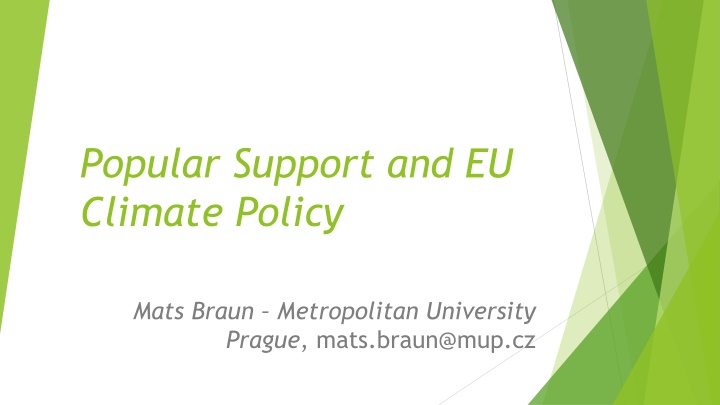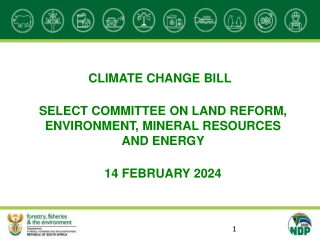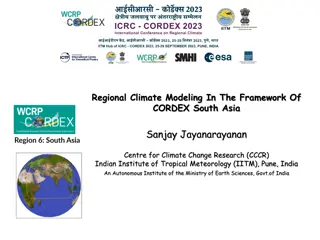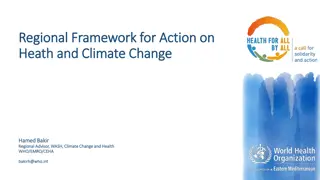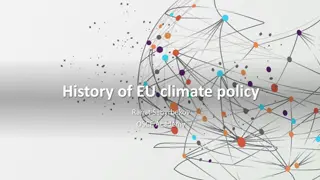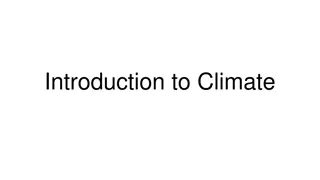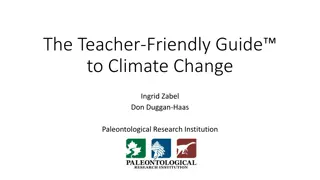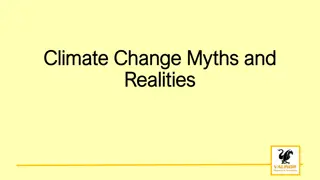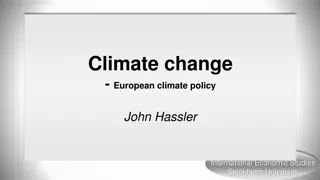Popular Support and EU Climate Policy
This article by Mats Braun from Metropolitan University Prague discusses the relationship between popular support and EU climate policy. The author delves into the dynamics of public opinion and its impact on shaping climate strategies within the EU framework. Through an insightful analysis, the article sheds light on the intricacies of garnering support for sustainable initiatives at a broader political level.
Download Presentation

Please find below an Image/Link to download the presentation.
The content on the website is provided AS IS for your information and personal use only. It may not be sold, licensed, or shared on other websites without obtaining consent from the author.If you encounter any issues during the download, it is possible that the publisher has removed the file from their server.
You are allowed to download the files provided on this website for personal or commercial use, subject to the condition that they are used lawfully. All files are the property of their respective owners.
The content on the website is provided AS IS for your information and personal use only. It may not be sold, licensed, or shared on other websites without obtaining consent from the author.
E N D
Presentation Transcript
Popular Support and EU Climate Policy Mats Braun Metropolitan University Prague, mats.braun@mup.cz
Share of respondents stating climate change as their main environmental worry (Eurobarometer) 2003: 39 percent 2007: 57 percent 2011: 34 percent The single most serious problem facing the world: 2011: 20 percent 2013: 16 percent
The Climate and Energy Package 2008/09 Internal climate change policies for period after 2012 Targets: 20/20 by 2020 - Revision of the Emission Trading Directive - Effort sharing decision, national targets for non ETS sectors - Binding national targets for renewable energy sources - Directive on carbon capture
Why the Climate and Energy Package in 2008? The role of the European Commission - Increased concern in the Commission about its popular support end of the permissive consensus - The failure of the Treaty Establishing a Constitution for Europe (2005) - United Nations Framework Convention on Climate Change
Was the role of supranational institutions strengthened? - In the ETS an EU wide emission cap (21%) replaced National Allocation Plans, enhancing the role of the EC - Preferences with the commission for market based solutions, i.e. the ETS - Renewable energy turn form non- binding to binding national targets
Possible outcomes of Europeanization according to Claudio Radaelli (2003) Inertia Absorption Transformation Retrenchment
How come agreement possible in 2008? Rhetorical Entrapment Unwillingness to go against the interests of France and Germany Several Compromises made - Binding commitments on renewable challenged and watered down The Central and East European member states at the time still new
2030 EU Climate and Energy Policy Framework (October 2014) 40% emission reduction target by 2030 ETS 43% reduction and non-ETS sectors 30% by 2030, relative to 2005 Renewable energy target, at least 27%, but binding only on EU level Non binding energy efficiency target of 27% 15% electricity interconnections target
Differentiated integration and its limitations Renewable energy targets New Governance System State aid guidelines of the EC The role of the European Council, reinstalling the veto right? - - -
Thank you for your attention Contact: mats.braun@mup.cz
